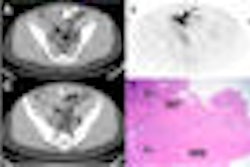PET/CT conducted six to eight weeks after patients complete chemoradiotherapy for head and neck cancer may help identify those who will respond to treatment and those who will require surgical follow-up, according to a report in the November issue of the Archives of Otolaryngology -- Head & Neck Surgery.
Researchers at the Southern Illinois University School of Medicine in Springfield, led by Dr. James Malone, analyzed 31 patients with advanced-stage head and neck cancer who were treated with combined chemotherapy and radiation therapy between 2004 and 2006. All patients underwent PET/CT to detect evidence of persistent tumors six to eight weeks after the completion of treatment, and then were tracked for a median of 24 months.
The study team found that for the entire patient population, PET/CT had a sensitivity of 83%, specificity of 54%, positive predictive value of 31%, and negative predictive value of 92% in assessing the response of the tumor to treatment.
In the 21 patients whose disease had spread to surrounding lymph nodes before treatment, sensitivity was 75%, specificity was greater than 94%, positive predictive value was greater than 75%, and negative predictive value was 94%. For the 10 patients whose cancer was located in the neck only, specificity was 92% and negative predictive value was greater than 92%.
"On the basis of this study, PET/CT performed six to eight weeks after the completion of intra-arterial chemoradiotherapy for advanced squamous cell carcinoma of the head and neck is a valuable tool for measuring treatment response and facilitating clinical decision-making," the authors wrote. "In addition to early prediction of treatment response, PET/CT provides early detection of distant metastases, which permits earlier intervention in patients with distant disease."
Additional investigations of PET/CT in homogenously treated patient populations with consistent timing of post-treatment scans are necessary to detail the role of PET/CT in managing advanced squamous cell carcinoma of the head and neck, according to the authors.
Related Reading
FDG-PET/CT scans spot head and neck cancer return October 14, 2009
FDG-PET/CT helps track pediatric bone and soft-tissue tumors, June 16, 2009
FDG-PET/CT shows early chemo results, April 16, 2009
FDG-PET/CT reveals occult metastasis of head and neck cancer, September 7, 2007
Copyright © 2009 AuntMinnie.com




















